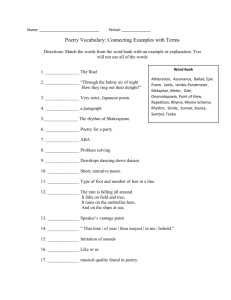Explicating poetry
advertisement
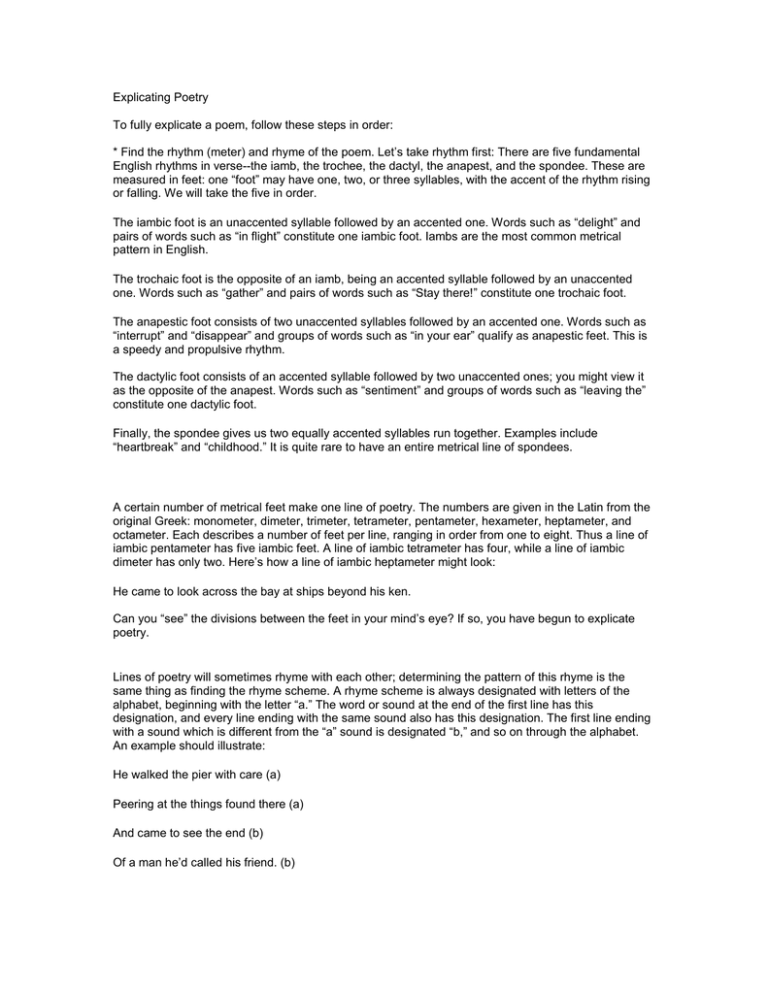
Explicating Poetry To fully explicate a poem, follow these steps in order: * Find the rhythm (meter) and rhyme of the poem. Let’s take rhythm first: There are five fundamental English rhythms in verse--the iamb, the trochee, the dactyl, the anapest, and the spondee. These are measured in feet: one “foot” may have one, two, or three syllables, with the accent of the rhythm rising or falling. We will take the five in order. The iambic foot is an unaccented syllable followed by an accented one. Words such as “delight” and pairs of words such as “in flight” constitute one iambic foot. Iambs are the most common metrical pattern in English. The trochaic foot is the opposite of an iamb, being an accented syllable followed by an unaccented one. Words such as “gather” and pairs of words such as “Stay there!” constitute one trochaic foot. The anapestic foot consists of two unaccented syllables followed by an accented one. Words such as “interrupt” and “disappear” and groups of words such as “in your ear” qualify as anapestic feet. This is a speedy and propulsive rhythm. The dactylic foot consists of an accented syllable followed by two unaccented ones; you might view it as the opposite of the anapest. Words such as “sentiment” and groups of words such as “leaving the” constitute one dactylic foot. Finally, the spondee gives us two equally accented syllables run together. Examples include “heartbreak” and “childhood.” It is quite rare to have an entire metrical line of spondees. A certain number of metrical feet make one line of poetry. The numbers are given in the Latin from the original Greek: monometer, dimeter, trimeter, tetrameter, pentameter, hexameter, heptameter, and octameter. Each describes a number of feet per line, ranging in order from one to eight. Thus a line of iambic pentameter has five iambic feet. A line of iambic tetrameter has four, while a line of iambic dimeter has only two. Here’s how a line of iambic heptameter might look: He came to look across the bay at ships beyond his ken. Can you “see” the divisions between the feet in your mind’s eye? If so, you have begun to explicate poetry. Lines of poetry will sometimes rhyme with each other; determining the pattern of this rhyme is the same thing as finding the rhyme scheme. A rhyme scheme is always designated with letters of the alphabet, beginning with the letter “a.” The word or sound at the end of the first line has this designation, and every line ending with the same sound also has this designation. The first line ending with a sound which is different from the “a” sound is designated “b,” and so on through the alphabet. An example should illustrate: He walked the pier with care (a) Peering at the things found there (a) And came to see the end (b) Of a man he’d called his friend. (b) He found him on his side (c) With his face turned toward the sea (d) It was there that he had died (c) Wishing for his Annabelle Lee. (d) This little bit of doggerel, inspired by the worst of Poe, has two stanzas. The first is made up of two pairs of lines called couplets rhyming aa and bb; the second stanza has a more common staggered pattern (or rhyme scheme) of cd cd. Four line stanzas, by the way, are called quatrains. They used to be quite popular. Determining the meter and rhyme scheme of a poem is the first step in explicating it. We will now examine the next steps. * Record and analyze any devices of sound. Alliteration, for example, is noteworthy: it is the repetition of word sounds, like “Heavy weighs the heart that holds it in.” Note that this is usually a repetition of initial sounds, but sometimes it can be word-internal as well: “The moan of doves in immemorial elms, And murmuring of innumerable bees.” (Tennyson) The brothers of alliteration are assonance (the repetition of vowel sounds alone) and consonance (the repetition of consonant sounds alone). Onomatopoeia is the creation of words in imitation of sounds, such as the term “buzz” derived from the “bzzzzzzzz” of bees. * Record and analyze any devices of sense (figurative language). Metaphor and its sibling, simile, are common poetic devices. A metaphor makes a connection between two things, be they places, objects, or ideas: “My love is a rose/ forever blooming.” A simile is a metaphor using the words “like” or “as.” A symbol is related to these two in that it is a visible sign of something invisible, perhaps an object or sign with cultural significance and the capacity to excite an emotional response (i. e. the American flag appearing in so many places these days). I personally make the distinction between metaphor and symbol in another way as well: a metaphor usually marks a one-to-one correspondence (i. e. love = rose), while a symbol usually offers us multiple meanings and interpretations (the flag could stand for a great many ideals, places, etc.). * Finally, record and analyze the theme of the poem. What is the controlling idea of the poem, and how does this theme reveal itself? When does it reveal itself? In the person of the author, a character, or a narrator who seems to be both at once? If you can answer these questions—and then, better yet, place the theme in a larger context, whether it be historical, political, or what have you—then you can understand a poem to a very full extent. In analyzing its rhythm and rhyme, its devices of sound and sense, and its theme, you have explicated it. The process might even give you a greater respect for poetry itself.
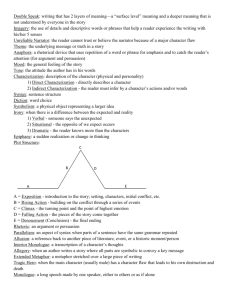
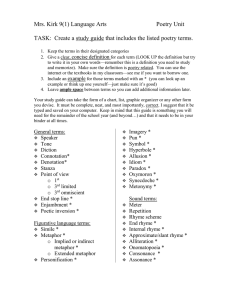
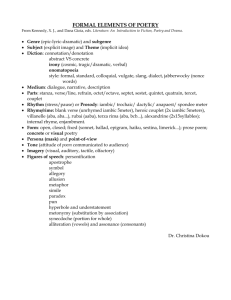
![English poetic terms[1].](http://s3.studylib.net/store/data/009640365_1-09d91eea13bb5c84d21798e29d4b36a3-300x300.png)
